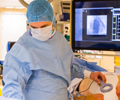
October 2018
Paul Foley
Abstract

Pacing practice has moved on from the start with unipolar pacing and now practice includes implantable defibrillators and cardiac resynchronisation therapy (CRT) for the treatment of heart failure, with parallel developments in remote follow up. Direct His Bundle pacing is now feasible using specially designed guide catheters and a standard pacing lead and appears to have significant benefits with reductions in heart failure hospitalisation, atrial fibrillation and mortality.
The supplement also looks at progress in pacemaker and defibrillator lead extraction, as well as the fast evolving field of leadless pacing. We are pleased to provide �
|
Full text

October 2018 Br J Cardiol 2018;25(suppl 3):S12–S19 doi:10.5837/bjc.2018.s14
Francisco Leyva
Abstract

Professor Francisco Leyva
Introduction
Cardiac resynchronisation therapy (CRT) is a standard treatment for patients with heart failure (HF), impaired left ventricular (LV) function and a wide QRS complex. The therapy emerged following the recognition that disturbances in inter- and intra-ventricular conduction contribute to LV dysfunction. Since its first clinical use,1,2 robust evidence from randomised-controlled trials (RCTs) has supported its use in patients with severe and mild HF. In combination with defibrillation (CRT-D), CRT reduces mortality from pump failure and sudden, arrhythmic cardiac death (SCD).
Since the last RCTs on CRT,3 th
|
Full text

June 2014 Br J Cardiol 2014;21:72–4 doi:10.5837/bjc.2014.016
Thanh T Phan, Muhammad Awan, Dave Williams, Simon James, Andrew Thornley, Andrew G C Sutton, Mark de Belder, Nicholas J Linker, Andrew J Turley
Abstract

Introduction
Occupational radiation doses in fluoroscopy-guided interventional procedures are highest among medical staff using X-rays, particularly cardiologists involved in interventional procedures.1 The danger of radiation, such as radiation-induced cataracts in operators,2 has led to a significant focus on radiation safety in the cardiac catheterisation laboratory. Garments, lead goggles, skull caps, ceiling suspended shields, curtains under the table, and other protective equipment, provide a significant reduction in occupational doses.3 It is necessary for cardiologists to wear personal dosimeters during procedures for personal safety
|
Full text
March 2010 Br J Cardiol 2010;17:69-70
Abstract

Optimising care
UK hospitals should set up acute heart failure units to help raise standards of care, according to Professor Henry Dargie (Golden Jubilee National Hospital, Glasgow).
Presenting the inaugural Philip Poole-Wilson memorial lecture (see box), Professor Dargie said that there have been great improvements in heart failure treatment, with effective drugs, devices and interventions, plus a multidisciplinary team approach. In addition, clinical trials have shown a 50% absolute reduction in heart failure mortality with modern treatments, proving what can be achieved with specialist care.
But trial results are not being reproduced in c
|
Full text





